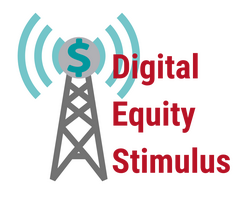 The COVID-19 crisis has highlighted the lack of digital equity for millions of households within communities of all kinds – big cities, small towns, suburban as well as rural and tribal communities. The majority of federal resources focused on the digital divide addressed the lack of broadband service in rural areas. While the challenge of the availability of internet service is urgent, our nation’s digital divide is also driven by huge disparities in broadband adoption.
The COVID-19 crisis has highlighted the lack of digital equity for millions of households within communities of all kinds – big cities, small towns, suburban as well as rural and tribal communities. The majority of federal resources focused on the digital divide addressed the lack of broadband service in rural areas. While the challenge of the availability of internet service is urgent, our nation’s digital divide is also driven by huge disparities in broadband adoption.
Through stimulus packages, broadband affordability was directly addressed while other stimulus funding is addressing digital inclusion in general (affordable or subsidized home internet service and devices along with community-based digital literacy training and navigation) through open ended funding provisions. To encourage use of stimulus funds for digital inclusion, NDIA encourages digital inclusion practitioners and advocates to share information about local programming with local and state elected officials, along with local and state broadband offices.
The $1.9 trillion American Rescue Plan (ARP) includes provisions that will or could cover the cost of broadband service and devices, broadband infrastructure deployment, broadband mapping and broadband adoption. The rules for use of these funds have not yet been distributed by the authority agency.
-
-
- The Emergency Connectivity Fund ($7.171 billion) – Reimburses schools and libraries for providing free broadband service (and connected devices) to students and patrons at their homes. This Fund is likely to be used for sponsored / single payer agreements.
- Institute for Museum and Library Services ($200 million) – Grant funding for necessary expenses to carry out museum and library services.
- The Coronavirus Capital Projects Fund ($10 billion) – Treasury will distribute funds to States, territories, and Tribal governments to carry out critical capital projects directly enabling work, education, and health monitoring, including remote options, in response to the pandemic. The funding could be limited to broadband and broadband adoption.
- The Local Fiscal Recovery Fund ($350 billion) – Treasury will distribute funds to municipalities and counties, tribes, territories and states to keep first responders, frontline health workers, teachers, and other providers of vital services safely on the job as states, local governments, Tribes, and territories roll out vaccines and fight to rebuild Main Street economies. Digital inclusion is assumed to be an eligible use of funds.
- The Homeowners Assistance Fund ($9.961 billion) – Treasury will make grants to states to administer programs assisting homeowners with mortgage payments and related costs including internet service.
-
The Consolidated Appropriations Act (CAA), enacted on December 27, 2020 includes the Emergency Broadband Benefit (EBB) program – $3.2 billion to reimburse internet service providers $10 to $50 per month for providing broadband service to households (up to $75 a month for tribal households) and up to $100 reimbursement for tablets and laptops, one per eligible household. For more information, see NDIA’s EBB Page.
The CAA includes other provisions that address digital equity. These programs fall under the authority of the National Telecommunications and Information Administration and Federal Communications Commission. Rules for these programs have not been released.
-
-
- The Office of Minority Broadband Initiatives ($285 Million) – Collaborate with Federal agencies to carry out broadband internet access service support programs to determine how to expand access to broadband internet access service and other digital opportunities in anchor communities.
- The Tribal Connectivity Program ($1 billion) – Grants to eligible entities to expand access to and adoption of broadband service on Tribal land; or remote learning, telework, or telehealth resources during the COVID–19 pandemic.
- Broadband Expansion to Underserved Communities ($300 million) – Grants for competitively and technologically neutral projects for the deployment of fixed broadband service that provides at least 25/3 in an eligible area (census block with at least one household or business that does not have access to 25/3).
-
This year promises to be a landmark year for digital inclusion advocacy. From legislation focused on affordability and subsidies to programs centered on digital skills, digital equity, devices and broadband infrastructure there are numerous opportunities to advance digital inclusion for underserved communities across the country.
